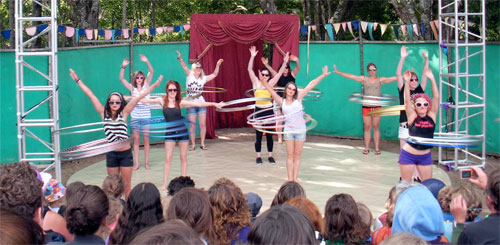
I dove into the Australian circus hooping culture last month and came away with some observations about how hoop dance and circus hooping differ.
Lexicon. Circus hoopers train and drill, hoop dancers practice and jam. This pretty much sets the tone for every other difference I noted.
Hoop Size. Circus hoopers prefer (and sometimes insist upon) hoops of a certain size - about hip height. I was told many times that the hoops I used were too small. Hoop dancers use whatever size they like or fits their groove.
Hoop Current. Hoop dancers use both currents with one dominant direction based on personal preference. Circus hoopers hoop counter-clockwise if they are right handed, and clockwise if they are left handed. This is to allow their stronger hand to perform the tricks. Circus hoopers really don’t use their second current.
Speed. Circus hoopers spin consistently fast, especially so when drilling. Hoop dancers move at different paces, but generally more slowly.
Precision and Control. Circus hoopers have it in abundance and without fail. Hoop dancers don’t always, because they have…
Flow. Being in the moment and reacting to changes in the hoop with a certain unconsciousness is what hooping is about for many hoop dancers. Circus hoopers don’t flow. They train so they can perform the same routine flawlessly every time.
Persona. Both in the dance and circus worlds, some hoopers have a strong stage persona and others let the hoops themselves have the spotlight.
Ensembles. It seems to me that circus hoopers tend towards ensemble work, with duo and group choreography that tells a story or paints an entertaining picture for the audience. Hoop dancers seem to perform alone more often or in groups that don’t interact as entertainment.
Community. Australian circus hoopers have a strong and vibrant community, with rivalries and partnerships among circuses all over the continent. They aren’t too interested in the hoop dance community. In fact, some circus hoopers call non-circus hoopers “feral.” When I mentioned hoop dance resources like hooping.org, and hoopcity, I got a lot of blank stares. Because the circus community is so tight, most hoop dancers haven’t heard much them. I’ll try to fix that soon with some links to the people I met in my travels.
Personally, after training with the circus hoopers for a couple of weeks, I identify more than ever as a hoop dancer. I admire the circus culture with my whole heart, and came away from training with a lot of new knowledge, inspiration and ideas. But I am a wuss and the rigid strictness of training and the pain of circus injuries isn’t my cup of tea. Maybe if I’d run away to the circus a little earlier in my life…
Posted by kuri at February 20, 2011 08:41 AMI found this fascinating. I am not a strong enough hooper to belong to either group, but I find the different factions interesting.
There are definitely similar distinctions in juggling but I have always noticed them most strongly in unicycling, where the difference in attitudes between different styles of unicyclist divides into several, fairly clear-cut subcultures.
Posted by: Julian on February 22, 2011 03:44 PMWhat a wonderful summary! I’m so glad you posted it. I wish I could write as good.
Posted by: Native American Hoopdancer on February 24, 2011 02:26 PMI liked your post so much I made a link to it from my blog.
Posted by: Native American Hoopdancer on February 24, 2011 03:01 PM